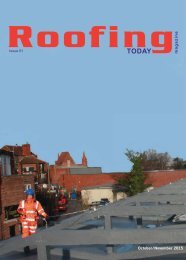Roofing
Roofing%20Today%20Issue%2065%20July%202016
Roofing%20Today%20Issue%2065%20July%202016
Create successful ePaper yourself
Turn your PDF publications into a flip-book with our unique Google optimized e-Paper software.
Sustainability<br />
Ensuring Product Sustainability and<br />
Traceability<br />
Simon Dayson, sales director – external envelope, SIG Design and Technology<br />
In the modern business environment, traceability and sustainability are<br />
becoming more important to customers than ever.<br />
While the demand for good quality products at low costs is as strong as ever, a<br />
key consideration for many purchasers is now where the materials have come<br />
from, how they have got there, and the impact that this has had.<br />
Organisations and suppliers are increasingly demonstrating a commitment to<br />
contributing to the wellbeing of communities. On a fundamental level, this<br />
means having a clean, safe and environmentally-friendly business, but in the<br />
present competitive environment it is important to exceed the minimum<br />
commitment criteria. This means going beyond national and specific<br />
environmental and health regulations, such as regulations covering the industry<br />
the business operates in – something that is particularly pertinent in<br />
construction, where a wealth of parties are involved in the creation of materials<br />
and products.<br />
From incorporating assessments of health and environmental impacts in decision<br />
making, to working with customers and suppliers to ensure products are<br />
transported and processed in environmentally friendly ways, this traceability is<br />
becoming integral to processes and ties in with having an open and frank<br />
approach.<br />
From a sustainability perspective, the whole product lifespan needs to be taken<br />
into account, and although this can cover multiple areas and applications,<br />
having this overarching oversight can help to make a key difference.<br />
Transparent and Comparable<br />
For some customers, this means an Environmental Product Declaration (EPD) -<br />
an independently verified and registered document that communicates<br />
transparent and comparable information about the lifecycle and environmental<br />
impact of products.<br />
The construction industry as a whole is aware of the challenge associated with<br />
developing sustainable construction methods, and yet the main raw material<br />
used – steel - is eminently recyclable. It is estimated that around 90 per cent of<br />
the steel from demolition goes on to be re-used, while 40 per cent of the steel<br />
that is used in new construction has previously been recycled.<br />
Through the use of modern machinery, upgrades and innovative techniques, the<br />
onus is on the industry to boost these figures further still and reduce the impact<br />
that products are having on the environment; as well as having an important<br />
effect on the long-term performance of the buildings and their structural quality.<br />
At a local level, there is also a need to recycle waste materials in a responsible<br />
manner and be as environmentally friendly as possible in areas where it is<br />
possible, but there remain challenges to adopting widespread sustainability.<br />
The EPD is certainly one step, as it is based on the international ISO standard<br />
and so adds a degree of certainty and authority to any declarations. By reporting<br />
environmental data over the entire lifecycle of products in accordance with the<br />
international standard ISO 14025, transparency is assured, and the fact that it is<br />
international, third-party verified and delivers flexible-source information, means<br />
ongoing monitoring is assured.<br />
Central to the EPD is a life cycle assessment (LCA), which provides information<br />
on the use of resources and energy, as well as various types of emissions. The<br />
extent to which this transparency can permeate the<br />
process is also affected by the manufacturer or supplier, as<br />
EPDs can contain environmental information additional to<br />
the LCA, including specific information about user- and<br />
the end-of-life phases, helping to create a fuller<br />
understanding<br />
Tying into this is an industry-wide – and worldwide –<br />
need to reduce the carbon footprint, not only of individual<br />
organisations, but sectors as a whole. SIG plc, parent<br />
company of Steadmans, has a commitment to reducing its<br />
carbon footprint, including achieving the Carbon Trust<br />
Standard of 2010, which is evidence of its environmentallyfriendly<br />
carbon credentials and complements wider<br />
ambitions to further enhance the company’s status as a<br />
Low Carbon Business.<br />
Ultimately, the extent to which organisations absorb<br />
sustainability into their operations is dependent on the<br />
industry they operate in and their wider approach, but<br />
there is an increasing connection between a business’s<br />
perception and the transparency of its processes, as well<br />
as the traceability of its products.<br />
Adopting this line of thinking has wider business benefits,<br />
which range from creating a transparent supply chain, to<br />
assuring potential affiliates and going beyond corporate<br />
and social responsibility, to become a true pillar of<br />
business with a demonstrable approach to product and<br />
service sustainability.<br />
For further information on Steadmans’ full range of<br />
products call 02840 660 516 / 016974 78277, email<br />
info@steadmans.co.uk or visit www.steadmans.co.uk.<br />
Page 46 <strong>Roofing</strong> Today<br />
Enquiry 22




